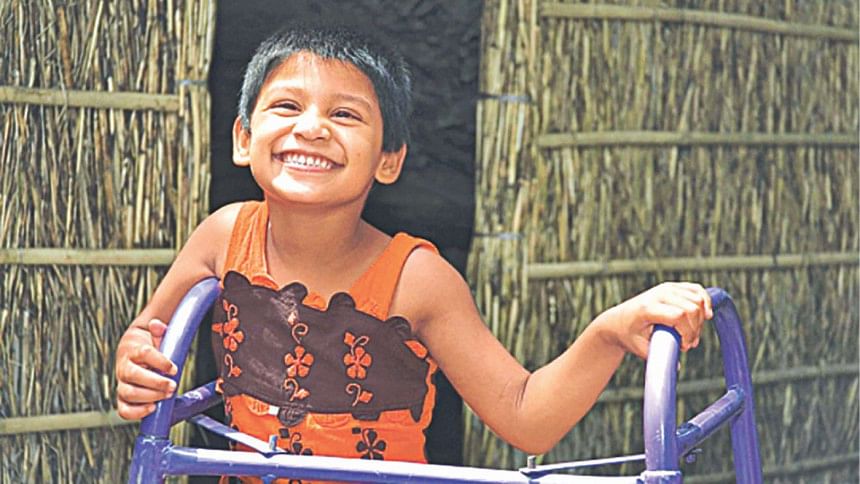Exploring the potential of children with disabilities

AMAR chhele kotha bolte pare na, haat tey pare na, tare porai ki hoibo?" (My son can neither speak nor walk; what is the point of educating him?)
These are the words of a mother of a child with cerebral palsy.
I pointed to a picture of Stephen Hawking and she laughed. "Eita toh bidesh, bideshe toh protibondhira chakri o korte pare. Amar chhele jiboneo chakri paibona" (This is abroad, where disabled people can even get jobs; my son will never get a job).
This mother, like many mothers, sees no value in investing in the education of her child with disability.
The predecessor of the SDGs was the MDGs, one of which was increasing equitable access to education. Bangladesh claimed to have achieved 100 percent primary education by the end of 2015 whereas it completely left out disabled children. Although eight of the 17 SDGs specifically talk about addressing inequality and inclusion, there are barely any structural initiatives that help achieve those goals, especially where it concerns children with psychosocial disabilities.
All government primary schools in Bangladesh have officially become inclusive schools due to a government order to enrol children with disabilities into regular schools.
Why does this matter?
This situation bespeaks a bigger problem than just inclusive education—what the purpose of education is for all of us. We talk about educational reforms in light of the fourth industrial revolution as we fear our current education system is not preparing our children to cope with it. Our current education system does not give the next generation the capacity to outsmart technology, as debates about Artificial Intelligence (AI) taking over jobs continue. The irony is that technology, which is meant to be our means to advancement and a better future, has become a source of concern.
If technology is the tool, mechanism and means for "our" advancement, isn't it really up to us to decide how that advancement looks?
Quality education nurtures diversity
Our real barrier for advancement is the lack of creativity and diversity, especially when it comes to countries such as Bangladesh. The reason why machines can replace our human capital is because we are still doing what the machines should be doing. When machines replace our labour, we need to go back to using our most humane skills and that too while also keeping up with technological advancement.
Worse than just mechanising us, our current education system has made us averse to diversity not just through excluding children with disabilities from mainstream schools, but also by making them invisible in society.
But children are not born with, or "acquire," a disability. They are "disabled," meaning they are limited by society, and their potentials are never explored, let alone utilised. Children without any form of physical or cognitive medical limitation, on the other hand, do not develop any capacity to adapt to the challenging environments of disabled children. With increasing use of technology, the idea of physical or learning disabilities will change, as physical work becomes more automated and learning becomes more virtual. This is what we need to nurture and harness.
Designing for disability is universal design
What if we designed for disability first, instead of designing for the mainstream, because not only is that inclusive but also proven to be more effective? What if with basic primary education in reading, writing, and critical analysis we taught people to design for disability—essentially for making our lives easier with the help of children with disabilities themselves.
Technological advancement geared towards creating assistive communication for children with disabilities is an option (for example, developing learning media that change colours to numbers for children with autism, etc.). One could argue these would only serve people with disabilities, but historically, that has been wrong.
When we think about disability inclusion, we think of complex infrastructural changes and sometimes even simpler ones such as ramps. However, for any building, a lift is now a given essential, and we hardly think of its necessity for disabled people. Text messaging was originally designed for people who are deaf but everyone sends text messages with little knowledge of what the original purpose was.
Yes, we need to reform our education and emphasise on science, technology, and unleashing creativity so that our labour force is doing work that requires quick adaptation and change of direction but above all, the moral of being inclusive, something that a machine can never replace.
The International Day of Persons with Disabilities, annually observed by the UN General Assembly resolution since 1992, has been an effort to make visible commitments to disability inclusion. The theme this year was aptly "Transformation towards sustainable and resilient society for all." To do that we need to conduct more research and allocate resources into building technologies that improve the learning of all kind of capacities, and support people with learning disabilities.
Our businesses need to start identifying these opportunities now to be in a position to not only benefit from but also steer the kind of advancement we are looking for. Let machines produce clothes to export and let's think of more potential ways to move ahead. We can start with being inclusive.
Shamsin Ahmed is the founder of the Identity Inclusion project which aims to identify the needs of people with psychosocial disabilities and break the barriers that affect their capacity to participate in the community.





Comments